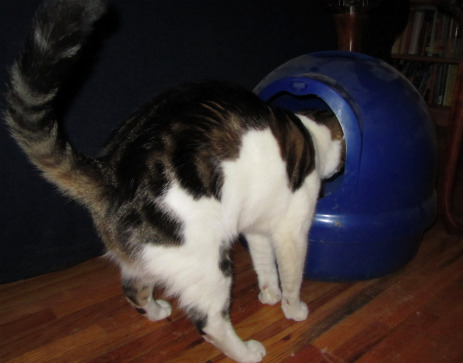Send your question to Umbra!
Q. Dear Umbra,
Having an indoor cat poses a question I haven’t found the answer to yet — what are the best options for a good sustainable cat litter, yet one that isn’t dusty, doesn’t track too much, and really works well. It may seem like a trivial issue, but consider how many cats are out there, doing their business, and the shovelfuls of litter really add up!
Mickey
Los Angeles
A. Dearest Mickey,
Good for you for being conscientious about what’s in your cat box. Kitty litter is no small matter. According to In Defense of Garbage by Judd Alexander, we Americans dispose of more than two million tons of it each year.
So you’re not just making a mountain out of a mole hill. In fact, common clay-based kitty litter is actually helping to destroy mountains, because it is acquired through strip-mining.
Cats are notoriously complex beings — charming at times, megalomaniacal at others. But do they hate mountains? I doubt it.
Another thing to note about strip-mined, clay-based litter is that it is usually made from bentonite or attapulgite/montmorillonite, which take several decades to biodegrade. That is some serious s*#t for our landfills to accommodate. Also, cats with respiratory problems often get more silica dust in their lungs from this type of litter. So take paws and avoid clay-based litter, for your cat’s health and the health of the planet.
What other options are out there? Well, there’s toilet training. But for indoor cats only!
You see, cat poop can carry toxoplasmosis, a parasite that can lead to other problems when flushed into our waste water system. Deaths of sea otters and wildlife have been linked to waste run-off carrying toxoplasmosis, which is often resistant to chlorine.
If your cat is an indoor cat and you feed them commercial food and not raw meat or dead small animals, they are most likely free of taxoplasmosis. Cats who go outdoors are a different story. Taxoplasmosis is contracted from mice and birds and other small animals infected with the disease. That’s a good reason to keep your feline friend indoors and keep outdoor cats from using your restroom. If you’re not sure whether Mr. Indoor Cat is toxoplasmosis-free, you can ask your vet to do a screening test for toxo antibodies. For more on taxoplasmosis and cats, the Centers for Disease Control have a helpful resource here.
Warning to indoor cat owners who are considering the toilet method: Teach a cat to flush, it will flush for life — without any regard to how much water it’s wasting. If you don’t believe me, just watch this cat flushing a toilet video, though I must warn you the song will be stuck in your head for 2 days.
Tossing biodegradable kitty litter into the trash is one good way to avoid the spread of taxoplasmosis. You could also compost your cat poop. Composting will make you the cat’s pajamas, Mickey, as you will be protecting waterways and landfills. If you choose this route, make sure to compost in your yard far from edible plants. You can also dig a foot-deep hole and bury your pet’s waste in your yard. (Just remember: Always wash your hands after dealing with cat remnants, so as to protect yourself from taxoplasmosis. Pregnant women, children, and people with immuno-deficiencies should avoid the litter box altogether, as they are at greater risk.)
The best way to reduce your cat’s carbon paw print, Mickey, is by using a biodegradable kitty litter.
If you go for store-bought, look for litter which contains reclaimed products or post-consumer waste. More eco-friendly litters are made with corn cobs, wheat, and newspaper. Though I can’t vouch for them personally, there are biodegradable commercial kitty litters out there that people seem to like, including World’s Best, Shweat Scoop Wheat Litter, Feline Pine, and Purina’s Yesterday’s News. You can get the full scoop here.
Although many eco-friendly litters are competitively priced, some are more expensive than their clay-based counterparts. But remember that cheap, clay-based kitty litter, like cheap oil or cheap anything, doesn’t account for its true cost to the environment. The extra dollar or so means you’re paying to not explode mountains, which is better for cats and people everywhere. The other advantage of biodegradable litters is they often last longer than clay-based. So you’re getting more bang for your buck.
If you’re feeling especially industrious, Mickey, you can make your own litter. One option is to use discarded wood shavings from a local carpenter or hardware store. You can also try mixing some dirt from your own yard. Or you could use newspaper. Just be sure to check with your local paper beforehand to make sure they’re using soy based inks. There’s some concern that petroleum based inks may be harmful to cats.
If you’re worried about odor absorption with your DIY litter — and who wouldn’t be? — add some baking soda. And remember that cats, being cats, may be fickle at first with any new litter, so you may need to be crafty in helping them acclimate, by mixing their old litter with the new litter to start.
Happy scooping, Mickey! Send my regards to your eco-friendlier feline. And let us know what you end up trying.
Cat’s meow,
Umbra



